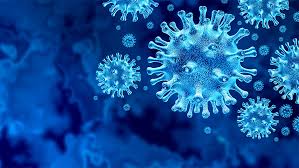
Even though much inhaled COVID-19 virus immediately penetrates into the lungs, some remains in the throat where it replicates to very high numbers–for instance, a peak at 711,000,000 RNA copies per throat swab day 4 (Wölfel R et al. Nature 2020;Apr 1). According to a Reinforcement Model of COVID-19 infections, many of these replicates descend into the lungs, where they furnish a stream of reinforcements that cumulatively outweigh the replication of the initial penetrating dose. Hence treating the throat with gargling seems highly desirable. This holds even if replicates also descend from the nasal passages because respiratory infections are a numbers game, and any reduction in virus numbers in the lungs is of utmost importance.2 Meanwhile, much of the virus from hands touching the face after picking up virus from surfaces as well as from the fecal-oral route may remain in the oral cavity and replicate before descending into the lungs.
Gargling can reduce transmission of virus via breathing, speaking, and coughing. Although the nasal passages tend to contain more virus in COVID-19 infections, the oral cavity contains a lot and may play an even greater role in transmission. Thus gargling pays double benefits, protecting oneself and others. This is particularly important with a pathogen as stealthy and contagious as COVID-19, one that leads to a large number of asymptomatic carriers who can unknowingly transmit the virus. So everyone should be gargling except those who have recovered and have immunity to the virus. The more people gargle, the safer everyone is, giving each individual a vested interest in encouraging others to gargle.
Gargling is inexpensive. It is easy to do. Its side effects tend to be negligible. Gargles are readily available or can be easily concocted. Povidone-iodine (0.25%), green tea catechins, and hypertonic saline have shown antiviral effectiveness; but other gargles may be equally or more effective. Gargling for 15 seconds 3-5 times a day during the pandemic seems advisable.
As a basic hygienic practice during epidemics, gargling resembles wearing a face mask. This makes it a valuable intervention for reopening economies after a lockdown. For poor people worldwide, gargling can provide a much-needed defense against the COVID-19 pandemic.
To this writer’s knowledge, only the Japanese government has recommended gargling against COVID-19. Japanese researchers have shown that gargling is protective against respiratory infections, though they have not yet published studies on gargling versus COVID-19. Gargling by tens of millions of Japanese might help account for Japan’s relatively low numbers of confirmed infections, even though the Japanese government made a series of mistakes, while months passed before lockdowns.
The U.S. Government needs to make funding clinical trials of gargling against COVID-19 a high priority. It needs to recommend gargling to all Americans. And it needs to collaborate with the Japanese and others to ensure that gargling is accorded all the attention, respect, and resources that a serious public health intervention deserves.
